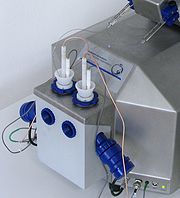Difference between revisions of "O2k-TPP+ ISE-Module"
| Line 1: | Line 1: | ||
{{ | {{Mainpage orobopedia}} | ||
{{Product | {{Product | ||
|description='''O2k-TPP<sup>+</sup> and Ca<sup>2+</sup> ISE-Module''': 2 potentiometric ion-selective electrodes ([[ISE]]), ISE-Service Kit and 2 [[Stopper\white PVDF\angular Shaft\side+6.2+2.6 mm Port|PVDF-Stoppers]], supported by the [[O2k-Core]]. | |description='''O2k-TPP<sup>+</sup> and Ca<sup>2+</sup> ISE-Module''': 2 potentiometric ion-selective electrodes ([[ISE]]), ISE-Service Kit and 2 [[Stopper\white PVDF\angular Shaft\side+6.2+2.6 mm Port|PVDF-Stoppers]], supported by the [[O2k-Core]]. | ||
Revision as of 21:07, 13 October 2012
O2k-TPP+ ISE-Module
| Description | O2k-TPP+ and Ca2+ ISE-Module: 2 potentiometric ion-selective electrodes (ISE), ISE-Service Kit and 2 PVDF-Stoppers, supported by the O2k-Core. |
|---|---|
| Product ID | 12300-01 |
| Type | O2k, O2k-Module, MultiSensor, Stopper, Catalogue |
| Link | O2k-Multisensor @OROBOROS, ISE-Manual, Tetraphenylphosphonium |
| Image |  |
O2k-TPP+ and Ca2+ ISE-Module consists of:
The query description has an empty condition.
General
The OROBOROS ISE system is designed with replaceable membranes making it possible to measure different ions such as TPP+ or Ca2+ with the same electrode housing.
O2k-Core and O2k Series A-E
For the Oxygraph-2k Series A-E, the O2k-TPP+ and Ca2+ ISE-Module is supported by the O2k-Core and by all O2k instruments with the O2k-MultiSensor electronic upgrade.
First O2k-TPP publication
Calcium electrode
A Ca2+ selective membrane with a composition similar to the one described by Simon and coworkers [1] has been tested with the OROBOROS ISE system and detection limits of less than 10 nM were achieved in Ca2+ buffered calibration solutions. There may be further optimizations of the membrane composition to ideally fit the the typical applications of OROBOROS customers. However, the main obstacle in establishing useful Ca2+ measurements appears to be not the Ca2+ sensitive membrane but the methodology of its application in a medium simulating intracellular conditions.
Note: The operation of a Ca2+ electrode at typically high extracellular Ca2+ concentrations is straightforward and devoid of the difficulties described here. These difficulties include both the calibration of the Ca2+ electrode and the planning of a biological experiment to use it.
Operation of the Ca2+ electrode
General
The general operation (assembly, ...) of the Oroboros ISE system is described in MiPNet15.03.
While working with the pX channel please always observe the guidelines for avoiding damage to the electronics by ESD.
Calculation of free Ca2+ concentrations
To work at physiological Ca2+ concentrations requires usually Ca2+ buffering by chelating agents. The calculation of c(Ca2+)free in such solutions is quite complicated and the results depend i.a on ionic strength, temperature, and - very strongly - on the pH. Tools for such calculations are available on-line at Chris Pattons MAXCHELATOR Page maxchelator.stanford.edu. Many calculations, published or implemented in programs, depend on a single set of data compiled by Martell and Smith [2]. Note that inspite of the availability of easy to use software tools the calculation of free Ca2+ concentration is not simple. The accuracy of these calculations is severely limited by several factors:
- Many underlying thermodynamic constants may not be known precisely
- Some thermodynamic constants necessary for adequate temperature correction may not be known at all
- It may be difficult to set the experimental parameters pH and ionic strength with the necessary precision
Inner filling solution
The following inner filling solution is used: CaCl2: 10 mM
EDTA: 50 mM
pH adjusted to 8.5 with KOH
Conditioning
Conditioning of the membrane is a controversial topic. If any conditioning is done, the used free Ca2+ concentration should probable not be much higher than the highest expected concentration during applications of the electrode.
Calibration
As a potentiometric method, the Ca2+ electrode delivers a signal that is (in the working range) linear to the logarithm of the free Ca2+ concentration. Therefore, the electrode is calibrated by plotting electrode signal vs. logarithm of the free Ca2+ concentration. Calibration of the Ca2+ electrode at low (< 1µM) Ca2+ levels is typically done by exposing the electrode to a series of Ca2+ calibration buffers. Each calibration solution typically contains a Ca2+ chelating agent, a pH buffer, CaCl2, and a salt (KCl) to adjust ionic strength. For suggested compositions see the literature in the reading list below. Examples from the literature may then be adapted to individual needs using the software tools mentioned above. The pH of all solutions have to be adjusted very carefully. For calibrations spanning a large range (several orders of magnitude) of free Ca2+ concentrations it is necessary to use calibration buffers with very different compositions. The nonlinearity of the electrode response in such calibrations may be mainly due to the difficulties in calculating the free Ca2+ concentration.
Application in biological experiments
You could help us in the development by explaining what you would like to do/ see in a Ca2+ experiment and what you expect from the electrode: what ca concentrations do you want to measure, Ca2+ release or uptake? what total concentration change in a 2 ml chamber (!) do you expect? Do you want to measure in a Ca buffered medium? (decreased sensitivity to changes) or without Ca2+ buffering but then how do you get to physiological Ca2+ concentration? Do you want to measure at physiological Ca2+ concentrations?.......
- Please add your comments in the Discussion page.
Click here to create an account
Reading list
We have complied a short reading list that may be of interest to those planing to to do Ca2+ measurements, with special emphasis on references describing the preparation of Ca2+ calibration buffers.
References





